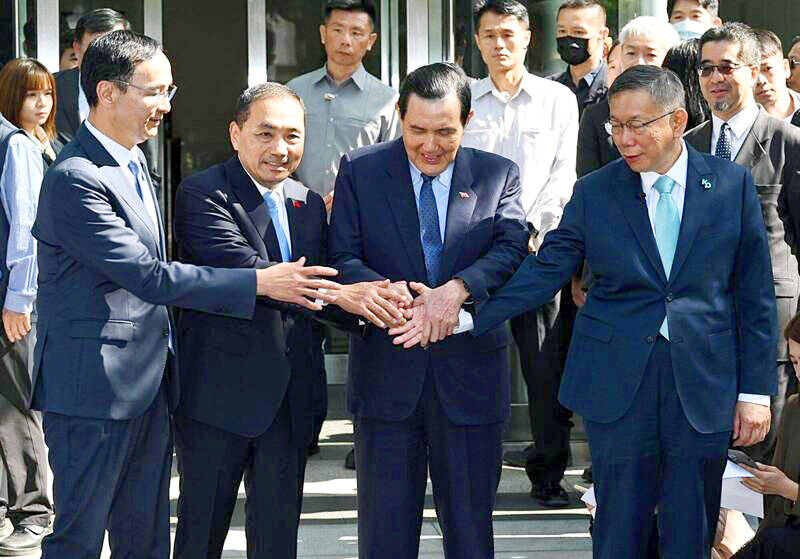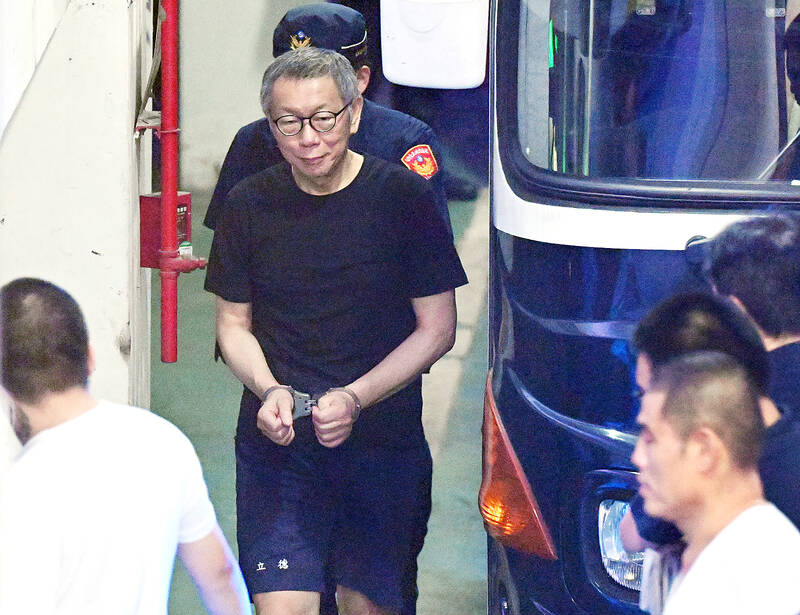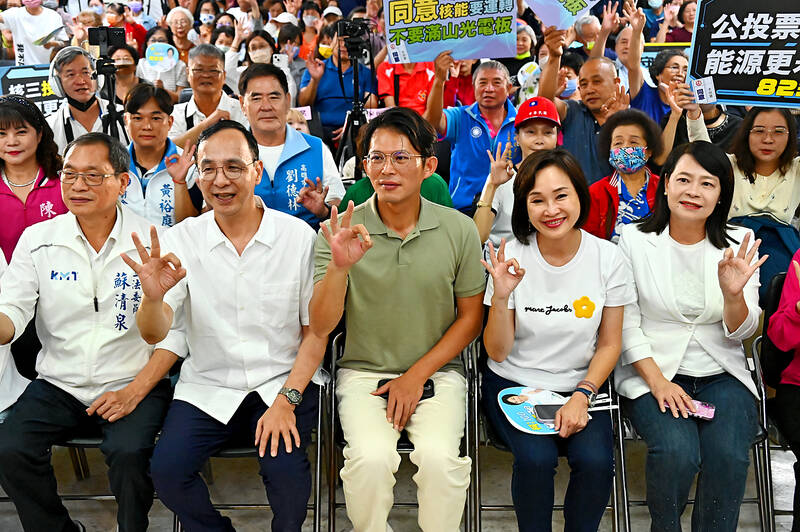Has the Taiwan People’s Party (TPP) changed under the leadership of Huang Kuo-chang (黃國昌)?
In tone and messaging, it obviously has, but this is largely driven by events over the past year. How much is surface noise, and how much is substance?
How differently party founder Ko Wen-je (柯文哲) would have handled these events is impossible to determine because the biggest event was Ko’s own arrest on multiple corruption charges and being jailed incommunicado.

Photo: TT file photo
To understand the similarities and differences that may be evolving in the Huang era, we must first understand Ko’s TPP.
ELECTORAL STRATEGY
The party’s strategy under Ko was clear: Build a pan-blue alternative to the Chinese Nationalist Party (KMT) that could draw on their supporters, while retaining enough of a distinct identity to appeal to moderate and independent voters that dislike the two major parties.

Photo: Liao Chen-huei, Taipei Times
Electorally, this is a sound strategy. In a series of surveys from 2022, KMT voters throughout most of the country were more likely to support them because they “hate the Democratic Progressive Party (DPP),” while DPP voters were more likely to pick “just because I like the DPP.” KMT supporters are more up for grabs than DPP voters if given a non-DPP alternative, and the DPP has for years been ranked the most popular political party.
There are blue-leaning districts that have proven time and again they will choose non-KMT candidates — even if they are pan-green ideologically — as long as they are not branded with the hated DPP label. Ko won two terms as Taipei mayor on this math.
At the beginning of his political career, Ko considered joining the DPP, but instead chose to chart an independent path, though he railed against the KMT. Once the DPP became the ruling party, he increasingly targeted them with his ire.

Photo: Lee Hui-chou, Taipei Times
He did not entirely abandon attracting some pan-green support, but openly allied with the KMT to oust the DPP from power. During his presidential run he described the DPP as a party that had lost its early ideals, and frequently blamed the DPP’s New Tide faction for leading the party astray.
Ko’s TPP ran on the slogan “rational, pragmatic, scientific” and mocked the antics of KMT lawmakers throwing pig guts on the floor of the legislature as “clowns.” The 2020-2024 TPP caucus did not conspicuously ally with the KMT at the time.
In the run-up to the national election last year, the KMT and TPP flirted, but both sides were suspicious, and only cooperated in limited ways, most notably in Taichung’s first electoral district, where the KMT knew they had no hope.
Their efforts to form a joint presidential ticket collapsed spectacularly on public television. During this period, Ko openly fretted about being “swallowed up” by the KMT and was concerned that his party could go the way of the People’s First Party (PFP).
Acutely aware his party lacked the size, experience, professionalism and star politicians to compete with the two major parties, Ko and the TPP worked effectively with what they had.
Their online marketing was highly effective, maximizing impact for a fraction of the cost. It was especially effective at attracting younger voters fed up with eight years of DPP rule. Their concerns over stagnant wages, spiraling housing prices and desire for change gave the TPP a boost.
These younger supporters formed a “little sprouts” movement of dedicated Ko supporters during the presidential run. This emphasis on younger voters was good electoral politics, as older voters were more likely stuck in their ways and less willing to switch parties. Support was strong among voters under age 50, but cratered precipitously above that age.
To maximize party talent, Ko laid out a two-year, local focus requirement for all lawmakers elected on the proportional representation party list. This stipulated that the lawmakers step down after two years, with the next in line on the party list stepping up to replace them.
This cleverly created the potential to cultivate twice as many political stars over four years. Each lawmaker was also assigned a geographical region of responsibility to cultivate ties and to ideally position them for future runs for local office.
Unlike the PFP, the TPP has the advantage that it is not a KMT breakaway party. Most of their talent has been developed internally, and the defections from other parties have been on an individual basis, not a movement en masse.
This makes it harder — though not impossible — for the KMT to poach TPP talent and absorb the party. One of the reasons Ko gave for being skeptical of creating a joint presidential ticket — despite his strong desire to take down the DPP — was that the TPP and KMT “had different DNA.”
IDEOLOGICAL INCOHERENCE
While Ko’s TPP was effective and clever in their electoral strategy, beyond the message of not being the DPP or KMT, they had little to offer.
Ideologically, the party was feeble.
Under “core philosophy” on their Web site they list “democracy,” “freedom,” “diversity,” “open-mindedness,” “nomocracy,” “human rights,” “caring for the vulnerable” and “sustainability.”
In each category they have a mere one-sentence explanation, and other than “nomocracy,” it is all boilerplate “of course” values that all major parties espouse.
The choice of “nomocracy” is interesting, and according to Google AI “emphasizes the impartial and consistent application of laws, whereas democracy focuses on popular participation and representation.” However, they never emphasized this concept, and their first “core philosophy” on their Web site under “democracy” they state “an open government and full public participation are our goals,” which is somewhat contradictory.
Notice some things missing from that list? There is nothing about relations with China, defense or foreign relations.
Ko has been fairly consistent on defense. He called for increased defense spending above three percent of GDP, considered increasing conscription beyond one year, and said “our stance is that we should prepare for war so that we will not be afraid of one.”
Though generally positive on ties with Washington, he accused Beijing of pushing Taiwan towards the US.
It is on relations with China were he was most inconsistent. Before the election, he said the DPP is too “pro-war” in dealing with Beijing, while the KMT is “too deferential.”
In a dig at the KMT, he billed the party as being “pro-Taiwan,” and almost always referred to “Taiwan” and almost never used “Republic of China.”
Mostly, he sounded light blue, promising to engage in dialogue to “reduce enmity” and vowed not to “provoke” Beijing. Regarding political unification, he said: “at this stage, ‘one China’ is impossible.” Notice that it does not rule it out eventually, just “at this stage.”
He said the TPP could not support the unpopular “1992 consensus” because “there is no market for it,” but repeatedly expressed hope for another formula to replace it. He tried using “both sides of the Taiwan Strait are one family,” but had to back away from that after public outcry.
At one point, he considered supporting a services pact with China — which the Sunflower movement of which he was apart arose to block — before finally backing away.
There is some evidence Ko used a deep blue intermediary to secure Beijing’s tacit approval to run for president and raise money from a pan-blue supporter. See “Ko Wen-je, KMT conspiracy and the most dangerous man in the world,” March 12, page 12.
Ko’s TPP was allied with the KMT, but it was a prickly relationship.
Then, starting in the spring, the TPP legislative caucus appeared to march in lockstep with the KMT, playing down their legislative disagreements and publicly doubling down on their alliance. Like the PFP, they became firmly part of the pan-blue bloc.
The TPP caucus convener is Huang Kuo-chang, and he appeared to be spearheading the new strategy.
Our next column examines the Huang era.
Donovan’s Deep Dives is a regular column by Courtney Donovan Smith (石東文) who writes in-depth analysis on everything about Taiwan’s political scene and geopolitics. Donovan is also the central Taiwan correspondent at ICRT FM100 Radio News, co-publisher of Compass Magazine, co-founder Taiwan Report (report.tw) and former chair of the Taichung American Chamber of Commerce. Follow him on X: @donovan_smith.

Oct. 27 to Nov. 2 Over a breakfast of soymilk and fried dough costing less than NT$400, seven officials and engineers agreed on a NT$400 million plan — unaware that it would mark the beginning of Taiwan’s semiconductor empire. It was a cold February morning in 1974. Gathered at the unassuming shop were Economics minister Sun Yun-hsuan (孫運璿), director-general of Transportation and Communications Kao Yu-shu (高玉樹), Industrial Technology Research Institute (ITRI) president Wang Chao-chen (王兆振), Telecommunications Laboratories director Kang Pao-huang (康寶煌), Executive Yuan secretary-general Fei Hua (費驊), director-general of Telecommunications Fang Hsien-chi (方賢齊) and Radio Corporation of America (RCA) Laboratories director Pan

The classic warmth of a good old-fashioned izakaya beckons you in, all cozy nooks and dark wood finishes, as tables order a third round and waiters sling tapas-sized bites and assorted — sometimes unidentifiable — skewered meats. But there’s a romantic hush about this Ximending (西門町) hotspot, with cocktails savored, plating elegant and never rushed and daters and diners lit by candlelight and chandelier. Each chair is mismatched and the assorted tables appear to be the fanciest picks from a nearby flea market. A naked sewing mannequin stands in a dimly lit corner, adorned with antique mirrors and draped foliage
The consensus on the Chinese Nationalist Party (KMT) chair race is that Cheng Li-wun (鄭麗文) ran a populist, ideological back-to-basics campaign and soundly defeated former Taipei mayor Hau Lung-bin (郝龍斌), the candidate backed by the big institutional players. Cheng tapped into a wave of popular enthusiasm within the KMT, while the institutional players’ get-out-the-vote abilities fell flat, suggesting their power has weakened significantly. Yet, a closer look at the race paints a more complicated picture, raising questions about some analysts’ conclusions, including my own. TURNOUT Here is a surprising statistic: Turnout was 130,678, or 39.46 percent of the 331,145 eligible party

The election of Cheng Li-wun (鄭麗文) as chair of the Chinese Nationalist Party (KMT) marked a triumphant return of pride in the “Chinese” in the party name. Cheng wants Taiwanese to be proud to call themselves Chinese again. The unambiguous winner was a return to the KMT ideology that formed in the early 2000s under then chairman Lien Chan (連戰) and president Ma Ying-jeou (馬英九) put into practice as far as he could, until ultimately thwarted by hundreds of thousands of protestors thronging the streets in what became known as the Sunflower movement in 2014. Cheng is an unambiguous Chinese ethnonationalist,